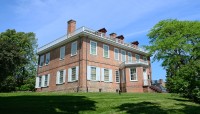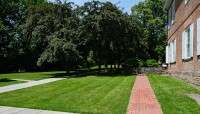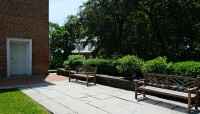Landscape Information
Located less than one-half mile west of the Hudson River and bound by linear residential streets, this 1.56-acre property features a brick Georgian residence (1764) oriented on axis with Schuyler Street. The property is set atop a lawn hillock that provides broad northeastern views. From 1763 to 1804 the site was home to Revolutionary War Major General and U.S. Senator Philip J. Schuyler. During his tenure the property measured 80-acres and featured a formal garden, orchard, working farm, and several outbuildings. After Schuyler’s death the property was reduced to one acre, to which was added a half-acre lot in 1815. In 1911 the property was acquired by the state and in 1917, on the 140th anniversary of the British defeat at Saratoga, it opened to the public.
Bordered to the south by a dense grove of deciduous trees, including maple and horse chestnut, the property descends steeply to Clinton and Catherine Streets to the east and north, respectively. The streets are framed by high stone walls (1916), the easternmost of which is further embellished with a metal fence and rows of maple trees.
From the property’s northeast corner, flights of stairs, each framed by stone walls, lead to a modest, curvilinear brick path and the residence’s eastern façade, shaded by a specimen locust tree. The path connects to a linear stone walkway and a former caretaker’s house, now a visitor center. Southeast of the residence is an east-west oriented path flanked by flowering deciduous ornamental trees and a modest Colonial Revival garden planted with flowering shrubs and clipped boxwood hedges.
The property was listed in the National Register of Historic Places and designated a National Historic Landmark in 1967. It is a contributing property of the South End-Groesbeckville Historic District, listed in the National Register in 1984, and is located within the Hudson River Valley National Heritage Area, designated in 1996.









